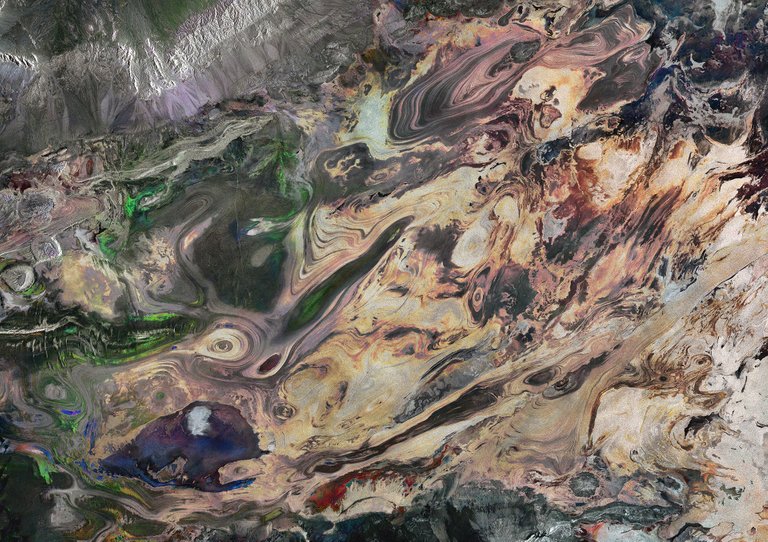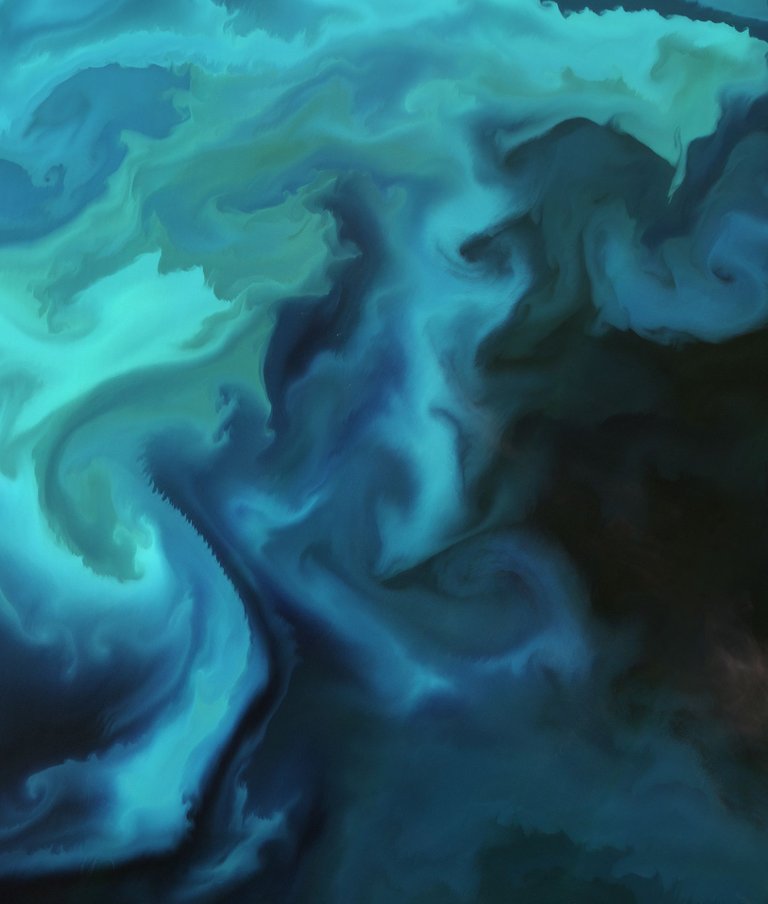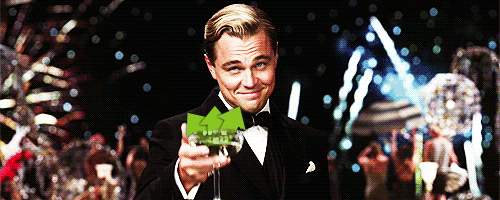In my series Beautiful satellite images of our Planet, I share some of my favourite images that have been taken by different satellites. I also try to provide a short explanation of what you see in the image and why it differs from what you would expect. Many of the comments I receive tend to mention how these images look a lot like paintings and I totally agree! However, some more closely resemble paintings than others. So, I thought I would put together of 3 images that I thought are really indistinguishable from art! I hope you’ll enjoy them :)
Dasht-e Kavir Desert, Iran

Radar Satellite image of the Dasht-e Kavir salt desert in southeast Iran taken by the European Sentinel-1 satellite image credit: ESA
You would be good to distinguish this one out from a selection of oil paintings! The many swirls and stark differences in colours make this picture one of my favourites. Unlike most images in my series, this is not an optical image but instead made out of compiling three different radar images taken over the same region. It combines three scans from Sentinel-1A’s radar on 21 January, 14 February and 9 March 2016, so about three weeks in between each image.
The image is a salt desert in southeastern Iran called Dasht-e Kavir. Those of you have read my previous posts might remember that salt deserts like these tend to accumulate different minerals over the years. The different colours, such as the vibrant blue, red and green seen primarily on the left half of the image, displays the changes that have occurred between the different data acquisitions during the three months. The strength of the colour reflects the size of the change, while each colour represents a different mineral.
To see what the area really looks like, you can compare it to this optical image taken 4 years earlier:

True colour optical image of the Dasht-e Lut salt desert in Iran taken by Envisat’s MERIS instrument on 2 April 2012
image credit ESA
Although the image does not cover the exact same region, you can still see the same salt dunes and mineral-rich ridges and furrows studied in the image above.
Earth-observing satellites are useful for finding and monitoring natural resources and minerals worldwide. This is especially the case for areas that are more remote and inaccessible than others. During the summer, temperatures in the desert can often reach 50 degrees Celsius, making it such an example.
A Plankton Bloom, Baltic Ocean

Natural colour image by the European Sentinel 2 Satellite of a plankton bloom in the Baltic Ocean
image credit: ESA
No one could fault you for mistakenly taking this satellite image of the Baltic Ocean to be a watercolour painting. Instead, this image taken by the European Sentinel 2A satellite is a completely natural-coloured optical image of a plankton bloom in the Baltic Ocean.
Since plankton is just as large a consumer of carbon as land-based plants, as well as the most basic component of the oceanic food chain, it is monitored routinely by satellites in order to observe changes over time. Indeed, the quantities and status of plankton at sea is also one form of data-input in climate-prediction models. Lastly, satellites are used to closely monitor and alert outbreaks of algae blooms due to their potential devastation of biodiversity and fishery resources. As the bloom exhausts the water of oxygen, fish may suffocate. Therefore, satellites are used to alert local fish farmers of harmful blooms as early as possible.
Although the phytoplankton floating on top of the waters which causes the bloom is too small to be individually seen, they occasionally get concentrated in one area. When these then produce chlorophyll for photosynthesis in sufficient numbers, it can colour the waters as seen in the satellite image above.
So, despite their potential negative impact on fisheries and biodiversity, no one can deny that they look beautiful from above! I’m sure that if you spend enough time looking at the image, you can make out shapes that resemble familiar shapes and beings.
Namib Naukluft Park, Nambia

Optical image taken by the European Sentinel 2 satellite image of the Namib Naukluft Park in western central Nambia
image credit: ESA
What you see in this natural colour satellite image is the world’s oldest desert, the Namib, together with parts of the Naukluft Mountain range. The place sees no direct rainfall but instead receives water coming in as fog from the Atlantic Ocean. These winds also create the sand dunes visible throughout the image. Due to the fog carried by the wind, the iron left in the sand dunes have long rusted. This has left the strong orange colour that dominates the image. Older dunes have accumulated more iron and experienced more rust, thus gaining a brighter orange colour as you can see in what I would think of as a “rust belt” across the centre of the image. Again, it looks almost like the stroke of a giant pencil has unevenly painted the landscape red.
Another interesting phenomenon can be seen at the bottom of the image. Here you can see the giant Tsondab River which starts at the very right-hand side. The river starts from the mountains which do see rain occasionally before flowing down to the lower and hotter desert plane. On the way, the water gathers salts and other minerals, but due to the high temperatures of the desert, the water eventually evaporates. This can clearly be seen in the form of the white area at the end of the river, where all the salts and minerals are left once the water is gone.
A highway runs through the top right part of the image as can be seen as the white line. On the top left is the Kuiseb River which you can see running between the orange coloured part and greyer and dark blue regions seen at the top left corner. The river blocks the movement of the southern dunes that would otherwise blow towards the north. This is why you see the stark difference in colour as the Irons and minerals brought down to the lower deserts stays on this side of the river. Another example of nature creating its own art!
Want to try processing new satellite images yourself?
All images in this post were taken by the European Sentinel 2 satellites and have also been processed by ESA, the European Space Agency. You can download the raw data from their satellite constellation yourself for free here, which can be processed professionally by the free and open source tool snap. You can also browse new satellite images online for free using the EO Browser.

Want to discover more science and technology related content on Steemit? Follow @steemSTEM to see weekly selection of quality science posts, as well as STEM-related contests. Are you interested in writing posts on related topics yourself? Make sure to join the steemSTEM channel on steemit.chat to engage with other scientists on steemit!
As always, take care and steem on!
For me, the second picture is the easiest to make out. The others mostly look abstract.
Those are some beautiful images. Our planet from a distance (and here on the ground in many places) is truly a work of art with every color in the visible spectrum.
I agree! I've always thought that nature has a much richer imagination than ourselves, it always seems to come up with shapes and structures at a scale which our minds can simply not grasp.
Really like those specially as a fan of satellite imagery. Do you know how much the colors are boosted I wonder in the original pics? or is that really how things appear ? I know you said "natural color" but just wanted to double check.
Nice artistic touch on the blended ones too.
I'm hoping for the day the satellite will bring the beautiful images of Nigeria :)
Maybe the satellite's resolution will be increased a little further to be able to locate my state. :) I'm just kidding.
Nice piece buddy
I could include a satellite image of Nigeria in my next post in the series for you if you want :)
Sure, I would be honoured
Please do!!!. I cant wait. I hail from Osun state. In case you can locate a beautiful image of somewhere in that state.
That second one is gorgeous. I'd probably put that on a wall. With the self-processing of the images, you can also get them in large resolutions?
The initial file for an optical image is usually 4.5GB ;) since it contains data from 13 different instruments in the case of the Sentinel 2 satellite.
Once fully processed (I.e you combine the data from the different sensors to make the image you want). You can still easily be left with an image file larger than 30MB.
Edit: And yes I agree it is beautiful :) you mean the rue colour optical image of the Dasht-e Lut salt desert or the Baltic Sea?
The Baltic Sea is also beautiful, but I especially like the second picture of the Dasth-e Lut salt desert in Iran.
Wow they really look as a work of art. Sometimes when I have issues working at teledetection I search in http://www.intelligence-airbusds.com/. As far as I know by myself it contains pictures with the best resolution. The las optical image looks like mars (despite the water).
Thanks for sharing these very nice photos. They look like abstract paintings at first glance but I'd print them on large photo papers and frame them like real paintings.
all of them look beautiful. my favorite is the second one tho! Simple look but its a product of a billion things. just like most things in life
I agree!
These are gorgeous! They remind me of abstract paintings. Upvoting and following.
Those are truly like pieces of art! I'm also happy that the rocket signature has found a nice suitable home ;)
Oh My. The plankton bloom in the Baltic Ocean is so beautiful. You are correct though. At first glance it does appear to be a watercolor image. Thank you for sharing.
These images look beautiful, I love the one from Iran. At least this reminds us that despite lots of unappealing situations in many countries, they still have a great and beautiful side.
These are some amazing corners of Earth. My favorite is the one with the rusty dunes. Digging your description there, making it easier to grasp what I'm looking at.
I bet you could sell the prints to a wider audience for hanging them up on walls!
I would have liked to know the scale of the images, although I understand that it ruins the art effect :-)
Wow! Dette er jo kunst!
Det synes jeg også! Kunne fint hat et par sånne på veggen hjemme :)
Kanskje jeg burde lage en nettbutikk hvor folk kan bestille satellittbilder og andre space images innrammet og så ha linker til det i postene mine? :D
This reminds my of life at different scales, there’s life everywhere, there’s art everywhere.
And yep, we are a small counscious, sppining in an earthship named Earth, spiraling trou time and space in unimaginable speed... and one thing is certain:
We are NEVER in the same place twice. Great images, i loved to see this @fredrikaa!
Images are nice, but where is this Baltic Ocean?
I only know Baltic sea...and 4 oceans...
they are very beautiful, it is very hard to see how beautiful they are if you are standing on it.
with the satellite we could see how amazing they are.
God made earth the best planet in the universe and gave it to us, I just wish we could appreciate it and take care of it because Its our home all
Some unique looking images! Thanks for sharing!
Glad you liked them!
Yeah, it gives a really unique perspective :)
You wouldnt want to do that over my home town in the UK, would look like a cats litter tray! Great art work though well done. :)
Give me an address ;)
If you can make my City look good, you are a true artist my friend!
Beautiful images, especially the plankton bloom. Thanks for sharing.
Thanks for the comment! Yes I liked that one too a lot, looks almost mysterious! :)
It seems to me simply beautiful that a picture taken with a satellite can look so good, keep up with your work that this is art for many
Yeah they are breathtaking! I'll be sure to keep it up ;) hope you'll like the next ones too!
It is art in my eyes as well :)
Wow.. .Thank you for sharing the Raw part of Earth, we hardly get to see ourselves. Big Thank you @fredrikaa
Thanks! Yes the planet is so beautiful you just need to take a step back sometimes and enjoy the natural beauty that we have in front of us every day :)
Nature never fails to amaze. True beauty and yes the second image needs a second look at
Indeed! Nature can come up with shapes and structures that we can never imagine ourselves :)
The Baltic one? Or the optical image of the salt desert?
These pictures arejust amazing,beautiful and attractive. Great work dude
Thanks!
Let me add another one on this by your permission. Picture of India on Diwali From Space. Tweeted by Astronaut Scott Kelly. :)

It's awesome! I love the images from the ISS too :) Perhaps I should do a compilation of them, but right now I stick to satellite images since it is what I work with :)
That would be really awesome! You really should post one! Do something out of box as they say! :P
Wow, there're no words to describe these images! Although I'd say STUNNING! Keep it up :)
Stunning sounds just about right :)
In macro scale, our planet resembles precious jewels and gemstones.
You think? That's something I haven't considered before :)
But yes, you find a lot of beauty in them!
Amazing! It looks like an abstract painting 🙌
I agree :)
Looking forward to see your future blogs 😊keep steeming sir!
Great pictures
great art..on scientific method..
love it..
upvoted
wow this is something new ... 1st i thought this is some abstract art created from fluid acrylics :) <3
This is amazing! 🌎✌🤓 #worldpeace
nice post

beautiful images
Its totally different, thanks for sharing this to us. Nice art:)
nice photography on planet..
thank's for sharing......
Nice one! Take care too and steem on!
This post has received a 1.56 % upvote from @drotto thanks to: @steemstem-bot.
Nice one
What a mind blowing images you got..it really shows the true form of the planet.
Looks like the surface at Jupiter
Amazing art.
Thats great
Well done! This post has received a 25.00 % upvote from @litasio thanks to: @steemstem-bot. Whoop!
If you would like to delegate to the @LitasIO you can do so by clicking on the following link: 10SP
Did you happen to see the satellite shot where it looks like a spaceship was caught on camera?
Check it out:
Ah yes those stories are good for falling asleep
wow @fredrikaa awesome images! Nature is simply amazing...our real treasure! We definitely should acquire more consciousness and take care of the planet, which is our real home and the only one we have!
If you also care about nature and environment, have a check on my last post about global warming. The images are really really shocking. I can guarantee they will impact you! Your support will be highly appreciated :)
https://steemit.com/photography/@albertoyago/is-global-warming-a-scam-like-donald-trum-says-these-images-will-shock-you
all of them look beautiful.
Creative painting @fredrikaa
Thank you for sharing! I am always amazed by how beautiful, mysterious, and powerful our planet is! I wonder what the ozark mountains look like from satellite?